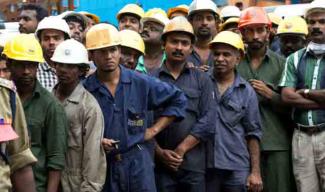Reverse Flow of Labour? A Cruel New Normal in Modi’s India?
The Department of Statistics of the Central Government has released the Periodic Labour Force Survey (PLFS) for July 2022 to July 2023. This survey had claimed that the All India all person labour force participation rate (LFPR) jumped from 49.8 percent in 2017-18 (the year PLFS began) to 57.9 percent, a whopping 8.1 percent in five years.
The worker population ratio (WPR), which measures the ratio of workers employed to the total workforce rose similarly from 46.8 percent in 2017-18 to 56 percent in 2022-23.
Now, the question arises - which sector has witnessed such a handsome growth?
The LFPR for males rose from 75.8 percent in 2017-18 to 75.5 percent in 2022-23, which is a slender increase. But surprisingly, on the other end, LFPR for females rose astoundingly from 23.3 percent in 2017-18 to 37 percent in 2022-23, an increase of about 60 percent! This statistical figure brings forth an intriguing female work force increase which should be examined at a proper perspective.
By perusing the figures, it becomes evident that the urban LFPR increased from 47.6 percent in 2017-18 to 50.4 percent in 2022-23 - by 2.8 percent. But the rural LFPR increased from 50.7 percent to 60.8 percent during this period, by an amazingly 10.1 percentage points. In rural areas, while the male LFPR increased from 76.4 percentage to 80.2 percentage, the female LFPR leaped massively from 26.4 percent to 41.5 percent signifying a massive, unsubstantiated increase! Does the data want us to believe that the rural economy is developing fast coupled with feminisation of labour force which is actually against the acknowledged trend at all India level? Where lies the riddle? What is the observation of CMIE?
Mahesh Vyas, the Chief of CMIE said, India's workforce is not rising in relation to its increasing working age population and remains largely stagnant at a little over 400 million in the past five years.
A worrisome aspect of Indian economy is reflected in the share of employment in agriculture which is rising significantly from 42.5 percent of the total employed in 2018-19 to 45.6 percent in 2019-20 indicating an unusual, regressive trend of large scale movement of labour from industry or service sector to the agriculture.
The PLFS provides details of 'employment - the nature of jobs, which are divided into three principal occupations - self-employed, regular wage/ salary, and casual. The self-employed are further divided into two classes, own account workers and unpaid helpers in household enterprises. The survey shows a huge increase in the number of self- employed to an all-time high which is 58 percent of the total employed in 2022-23! At this proportion in the total worker base of 580 million, 106 million are unpaid helpers in household enterprises in 2022 -23. This wage-less group of workers grew by about 28 million between 2017-18 and 2022-23 and it is noteworthy that ALL of them are women. These self-employed workers, which includes unpaid helpers, earned Rs 4,725 to Rs 5,071 in the last 30 days of survey period. The average casual female worker earned between Rs 259 to Rs 287 per day, or about Rs 7,098 for 26 days per working month. The labour force survey also shows the average regular monthly wages have diminished by over 20 percent in real terms between 2017-18 and 2022 -23. For self-employed and casual categories also, the real wages indicated a fall in real terms. No growth in average wages in five years clearly indicate a worsening quality of employment and stagnation of wages in the labour force survey that largely represents the bottom 60 to 70 percent of the population.
The International Labour Organisation categorically mentioned that only those who are doing 'decent ' jobs should be treated as employed. So, it is evident that unpaid workers in the self- employment category which has risen dramatically from about 40 million in 2017-18 to 95 million in 2022-23 should not be treated as employed as per the methodology prescribed by ILO and which is being followed by 92 countries.
A signature of Modinomics is a reverse flow of labour from industry to agriculture when the latter is beset with multiple crises. An overwhelming number of India's workforce is engaged in unorganised sector which faced three major blows of demonetisation, GST and pandemic induced lockdown. The mirage of huge employment, the facade of fastest growing economy, the stark reality of fall or stagnation in wages is the cruel “new normal” of Modi's India.

